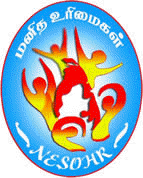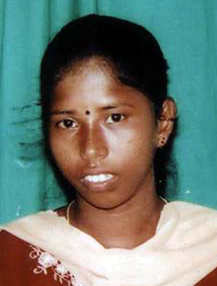  North East Secretariat on Human Rights Case Report, Dr N Malathy, NESOHR Secretary General, 6 January 2006 North East Secretariat on Human Rights Case Report, Dr N Malathy, NESOHR Secretary General, 6 January 2006 Informants The description given below of Tharshini’s disappearance on 16th December 2005 and the discovery of her body in an abandoned village well is put together from statements made by Tharshini’s relatives and neighbours to one of NESOHR’s committee members. NESOHR has made the decision to withhold the identity of the relatives and neighbours from this report because their safety may be compromised if these are revealed. NESOHR is ready to share this information with any leading international human rights organization that is willing to join us in taking up this case of the rape and murder of Tharshini. Tharshini  Tharshini is a 20 year old, single young woman who lived with her widowed mother in Pungudutivu (see map). Tharshini is one of three daughters to her parents. Both of her sisters are married. One of Tharshini’s sister, who is widowed, lived adjacent to Tharshini and her mother. The two households functioned more or less like a single household. Tharshini is a 20 year old, single young woman who lived with her widowed mother in Pungudutivu (see map). Tharshini is one of three daughters to her parents. Both of her sisters are married. One of Tharshini’s sister, who is widowed, lived adjacent to Tharshini and her mother. The two households functioned more or less like a single household.
Tharshini sat her GCE (OL) examination in 2001 from Kamalambikai Mahavidhyalayam in Pungudutivu. She tried to follow the GCE (AL) course, but gave up. Since then Tharshini has taught at the Uraitivu preschool. She also coached the sports teams at her old school. Tharshini and one of her female cousins earned money by weaving boxes made of Palmarah leaves. They did this task from the home of her cousin. For this purpose she visited her cousin’s house regularly and spent nights at her cousin’s house. At the time of her murder Tharshini was just finishing a course in sewing. She was turning out to be a good seamstress. Disappearance On the day of her murder, Friday 16th December, she left her home as usual around 6.15 pm to go to her cousin’s house and followed the small dirt footpath shown in the attached map. That night, both Tharshini’s and her cousin’s household thought Tharshini was at the other house. Unknowing to both households Tharshini never reached her destination. Next morning Tharshini’s mother started looking for Tharshini when she did not come back home in the morning as usual from her cousin’s house. Discovery of body More of Tharshini relatives, realizing that she has gone missing, joined in the search. They first found one of her slippers not very far from her home, along the small dirt foot path. During this search a few Sri Lankan Navy personnel from the Navy camp nearby came around and asked the family to show the place where they found the slipper. At this time everyone heard loud screams. The scream came from some of the boys from the village who have been checking the unused wells by stirring the well with long sticks. These boys had screamed when they just managed to bring up the hair of Tharshini above water level (Well 1 in the map). When the Sri Lankan Navy men heard the screams they all ran back to their camp. By this time it was 6.00 pm Saturday night. Tharshini’s relatives by now found a hat, worn by the Sri Lankan Navy, placed over the trunk of a Palmarah tree near the well where her body was found. They also found boot marks near the well. Later they located a bloodied palm leaf near the well. Slightly further away they found some dried palm leaves placed between two Palmarah trees in order to create a screen (Site of screen in the map) behind which one could hide on the side of the Navy camp. They also found Tharshini’s under clothes nearby which they said looked as if it was cut with scissors. Village people decided to camp near the well for the night to keep guard. Next day, relatives informed the Judge for the area. Village people refused to allow any of the Sri Lankan armed forces including the police to come near the well. Village people recovered her body from the well around 1.00 pm on Sunday in the presence of the Tamil Judge. The judge ordered the body to be taken to Jaffna Teaching Hospital for postmortem. Her body had been weighed down with heavy stones on her legs and around her waist using very thick ropes. The body was taken to the hospital still tied to these stones.
The judge ordered the Gramasevakar for the village, Ramesh, to take all the related items discovered at the site to be taken away and handed over to the Urkavalthurai courts. Postmortem The postmortem, conducted by Dr.Balasubramaniam, Judicial Medical Officer of Jaffna Teaching Hospital, confirmed that she had been raped and killed. Relatives who saw her body after the postmortem at the hospital said that she had several bite marks on her face. Her lips were ripped and they were stitched together by the hospital. She had stab wounds in her chest and near her hip. When Tharshini’s body was released to the family from the hospital following postmortem it was put in a vehicle to be taken to her home on Monday. Sri Lankan armed force personnel were standing near the vehicle and offered to put sacks of rice, sugar etc in the same vehicle in which Tharshini’s body was. Tharshini’s mother, furious by this act which she saw as an act to placate her, screamed at them in anger. More clues Once Tharshini funeral was over, the CID arrived. While searching the crime scene for clues they found the braces she used for her teeth not very far from the place where her slipper was first found. CID also found, further down the dirt road, towards the Sri Lankan Navy camp and away from her usual path to her cousin’s house, her other slipper. They also found a blue “key tag” with a few keys on it. CID has told the villagers that it is the type of key tag used by the Sri Lankan Navy. Harassment Since then, police, CID and other armed forces personnel have visited Tharshini’s relative’s houses several times to investigate. These officials who came to investigate have asked the family why the crime could not have been committed by the LTTE. Before Tharshini’s body was discovered, the investigating Sri Lankan armed forces have told the family that Tharshini may have joined the LTTE. Villagers also told us that the Sri Lankan security personnel are looking
for the people who stood guard around the well where Tharshini’s body was discovered on the night of December 17th to take some punitive action against them. Further Information: There were 32 households around Tharshini’s home. Most of the households have displaced. These lands and the wells in them were basically abandoned. These abandoned lands had many Palmarah trees that provided many hiding spots.
Other young women of the area told NESOHR that Sri Lankan Navy personnel hang around these abandoned land and if the girls ever look in their direction the Navy personnel would sign them to come near. They would also whistle and hoot at the young women. Villagers also said that the well near the temple (well 2 in the map) near the Sri Lankan Navy camp is used by the Navy to bathe. This well has no fence and was visible to public from public places. Navy men will stand around the well naked to take their baths. Villagers also said they would like to displace from the area after the rape and murder of Tharshini. However, the Sri Lankan armed forces, manning the checkpoints, is preventing them from leaving the area with all their household things. It must be noted these are very poor folks for whom leaving their household items will make a huge dent in their entire possession. NESOHR appeal Tharshini’s mother, in spite of all that has happened is insistent that she must complete the grieving period at her home according to the culture and tradition. This, the people believe, will grant peace to the departed soul. Given the gruesome way Tharshini’s life was taken this will seem far more important to Tharshini’s mother than any effort to lodge complaints or highlight her case at the international forums. Such is the nature of these simple village folks which act as a protective cover to those who have committed the crime. There have been innumerable cases like that of Tharshini during the three decades of Sri Lankan military occupation of Northeast. Only one case, Krishanthi’s rape and murder in 1996, was raised at international forum. Tamils often ask why the other cases were never brought at the international forums. Observing the simple nature of the village folks in Tharshini’s village, the answer to this seems obvious. Krishanthi was from a middle class family whose relatives were living in Colombo. Her family could readily make links with the sophisticated international human rights community. Where as most of the cases like Tharshini’s of the last three decades that NESOHR has investigated are from the lowest strata of the society who have no strong links with the sophisticated international human rights forums. NESOHR is appealing to the international human rights community, to join with NESOHR, and show that they do sincerely mean the claim of upholding universal human rights and come to the aid of this simple poor village family who has lost their caring, hard working daughter. By doing so they would also prevent many more future Tharshinies. |